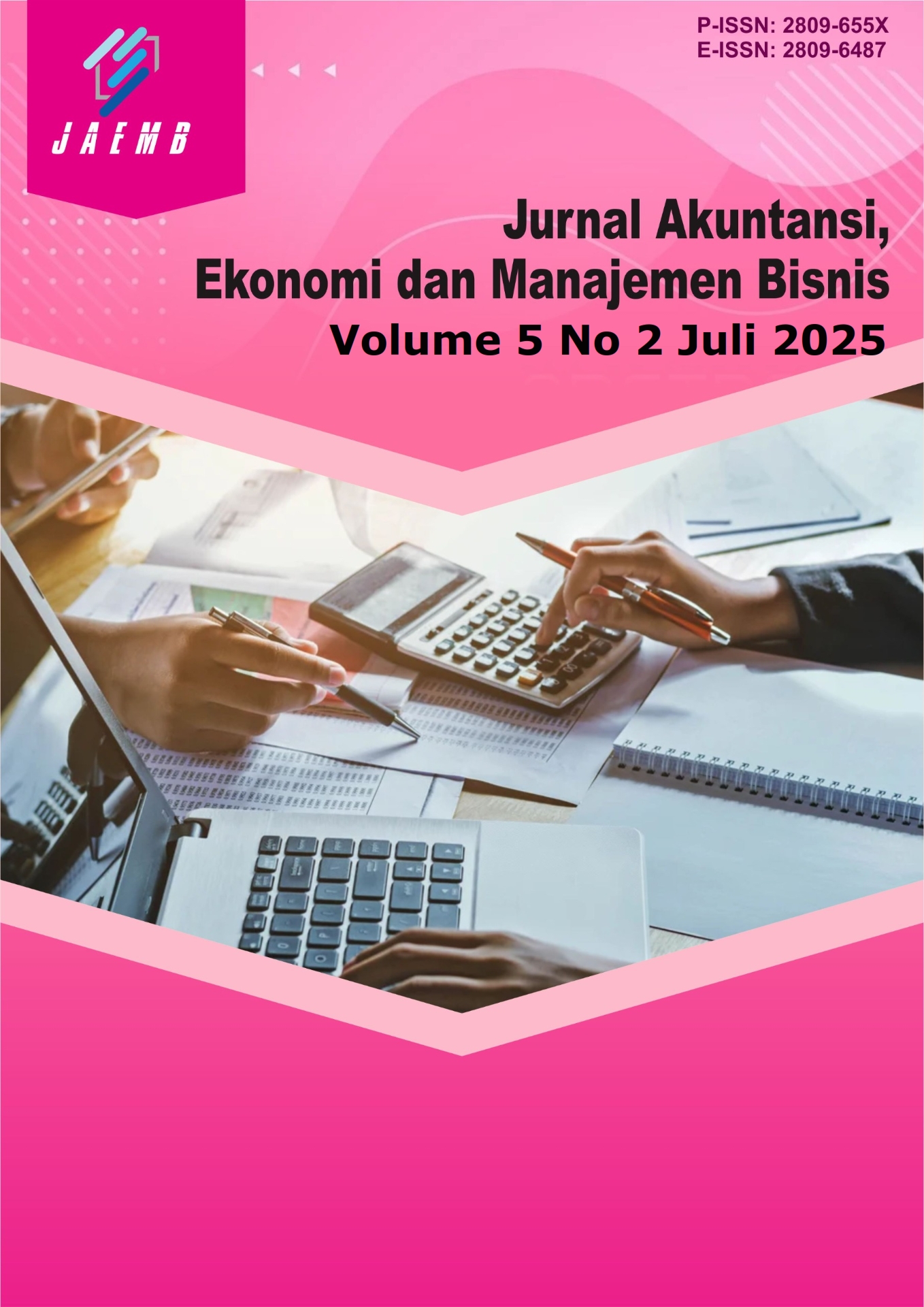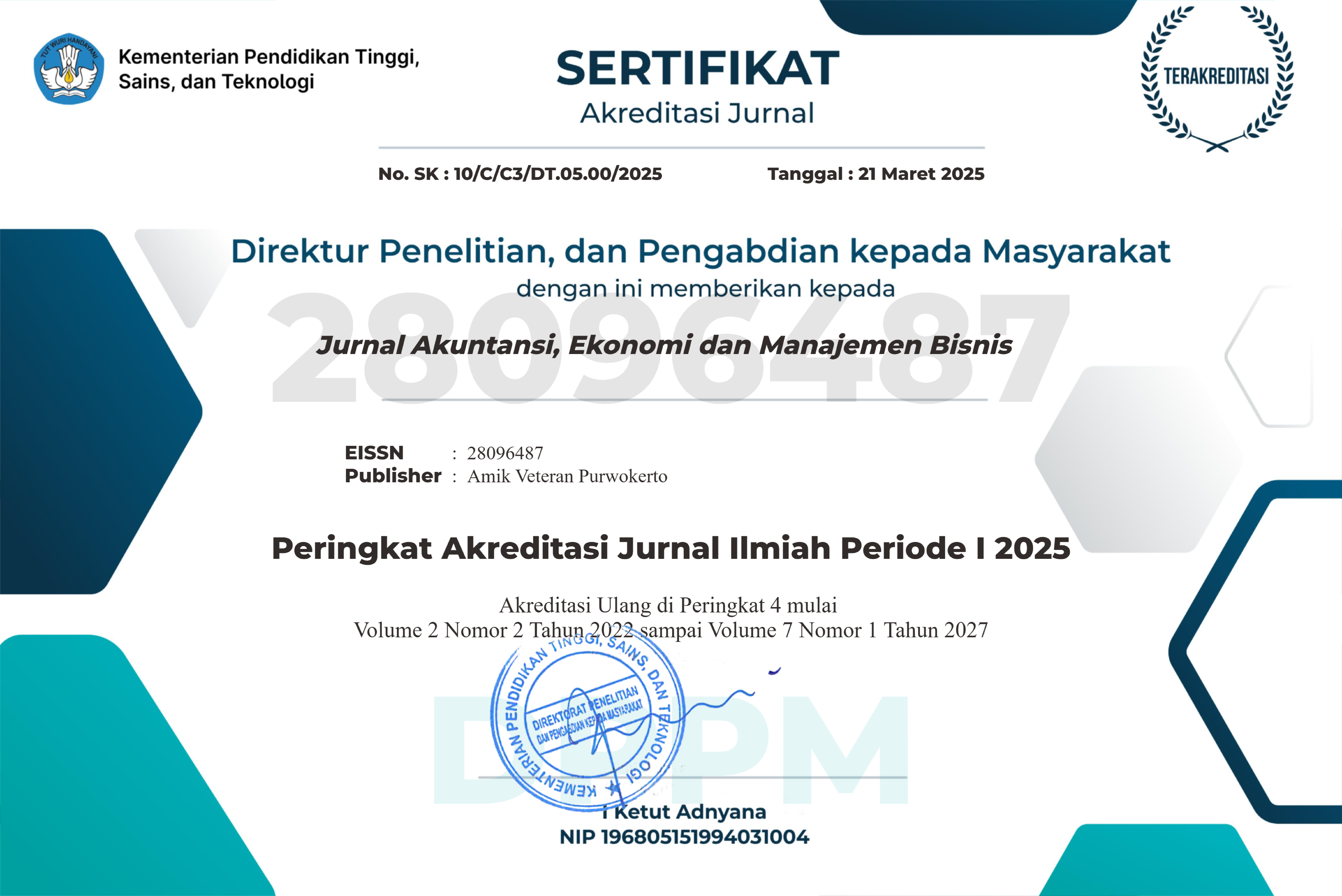Analisis Jalur Pada SDGs Terhadap IPM di JawaTimur
DOI:
https://doi.org/10.55606/jaemb.v5i2.5909Keywords:
Indeks Pembangunan Manusia (IPM), Sustainable Development Goals (SDGs), Umur Harapan Hidup (UHH), Tingkat Partisipasi Angkatan Kerja (TPAK), Rata-Rata Lama Sekolah (RLS), Path Analysis, Jawa TimurAbstract
This study examines the influence of Sustainable Development Goals (SDGs) indicators on the Human Development Index (HDI) across the ten highest-ranked districts/cities in East Java from 2020 to 2023. The primary issue addressed is the inconsistency between the Labor Force Participation Rate (LFPR) and HDI achievement, despite consistent correlations between Life Expectancy (LE), Mean Years of Schooling (MYS), and HDI. The objective is to analyze both the direct and indirect relationships between LE, LFPR, and MYS on HDI, and to assess the mediating role of MYS. A quantitative explanatory approach is employed using path analysis and panel data regression, with the Random Effect Model selected based on Chow, Hausman, and Breusch-Pagan tests. The results show that LE and MYS have a significant positive impact on HDI, while LFPR does not. Additionally, MYS partially mediates the relationship between LE and HDI but does not mediate the link between LFPR and HDI. These findings reinforce human capital theory, health capital theory, and sustainable development theory, highlighting education and health as central to human development. The study concludes that enhancing education and health quality has a more substantial impact on HDI improvement than increasing labor force participation alone, suggesting that development policies in East Java should strategically prioritize these sectors to accelerate SDGs achievement.
References
[1] D. T. Tikson, Indikator-Indikator Pembangunan Ekonomi. Semarang: Universitas Diponegoro, 2005.
[2] UNDP, “Human Development Report 2015,” in United Nation Development Programe, 2015.
[3] Ekbangsetda, “PEMBANGUNAN MANUSIA INDONESIA CAPAIAN DAN TANTANGAN,” Buleleng, 2019. [Online]. Available: https://ekbangsetda.bulelengkab.go.id/informasi/detail/artikel/pembangunan-manusia-indonesia-capaian-dan-tantangan-61
[4] United Nations, “Department of Economic and Social Affairs Sustainable Development Goals,” 2023. [Online]. Available: https://sdgs.un.org/goals
[5] Bappeda Kota Pontianak, “Habis MDGs Terbitlah SDGs: Menuju Pembangunan yang Berkelanjutan.” [Online]. Available: https://bappeda.pontianak.go.id/berita/habis-mdgs-terbitlah-sdgs-menuju-pembangunan-yang-berkelanjutan
[6] A. S. Alisjahbana and E. Murniningtyas, Tujuan Pembangunan Berkelanjutan di Indonesia: Konsep Target dan Strategi Implementasi. UNPAD Press, 2018. doi: 10.18356/9789210010788.
[7] R. I. S. Setiawati and F. Imamah, “Government Strategy in Addressing the Impact of Economic Growth and Energy Consumption on Environmental Degradation,” vol. 6, no. 2, pp. 343–364, 2023.
[8] Isma, “Bappenas Masukkan 169 Target SDGs dalam RPJMN 2020-2024,” Info Publik. [Online]. Available: https://infopublik.id/read/211686/index.html
[9] ekon.go.id, “Berhasil Naik dari Posisi 102 ke 75 di Tahun 2023, Menko Airlangga: Saya Optimis Indonesia Capai SDGs Tahun 2030,” KEMENTERIAN KOORDINATOR BIDANG PEREKONOMIAN REPUBLIK INDONESIA. [Online]. Available: https://www.ekon.go.id/publikasi/detail/5955/berhasil-naik-dari-posisi-102-ke-75-di-tahun-2023-menko-airlangga-saya-optimis-indonesia-capai-sdgs-tahun-2030#:~:text=“Dalam kurun waktu 4 tahun,posisi 102 di tahun 2019.
[10] Badan Pusat Statistik Kota Surabaya, “Indeks Pembangunan Manusia (IPM) Kota Surabaya Tahun 2022,” no. 16, 2022.
[11] localisesdgs, “No Title.” [Online]. Available: https://localisesdgs-indonesia.org/profil-tpb/profil-daerah/14
[12] M. Ismowati, S. Abbas, and A. Putri, “Sosialisasi Peran Pemuda dalam SDGs Tujuan 8 Pekerjaan Layak dan Pertumbuhan Ekonomi Inklusif di Desa Junrejo Kecamatan Junrejo Kota Malang,” J. Pengabdi. Mandiri, vol. 1, no. 12, pp. 2315–2322, 2022.
[13] A. I. Parapa, C. E. Chesynanda, S. Siswanto, and A. Kalondeng, “Path Analysis of Influence of Economic and Social Factors on the Human Development Index in South Sulawesi in 2022,” J. Mat. Stat. dan Komputasi, vol. 20, no. 2, pp. 426–439, 2023, doi: 10.20956/j.v20i2.32147.
[14] Badan Pusat Statistik Jawa Timur, “No Title.” [Online]. Available: https://www.bps.go.id/id/query-builder
[15] Thejatim, “Indeks Pembangunan Manusia Surabaya Tertinggi, Berikut Data Lengkapnya IPM se-Jatim 2022.” [Online]. Available: https://thejatim.com/indeks-pembangunan-manusia-surabaya-tertinggi-berikut-data-lengkapnya-ipm-se-jatim-2022/
[16] M. Todaro and S. Smith, Economic Development. 11th ed. Boston: Addison-Wesley, 2011.
[17] UNICEF, “SDG Goal 3: Good Health and Well-being.” [Online]. Available: https://data.unicef.org/sdgs/goal-3-good-health-wellbeing/
[18] S. N. Daeli and A. Fithriana, “Upaya Indonesia untuk Mencapai Sustainable Development Goals (SDGs) poin 3 Melalui Pos Bimbingan Terpadu (Posbindu),” Balcony (Budi Luhur J. Contemp. Diplomacy), vol. 4, no. 1, pp. 81–92, 2020, [Online]. Available: https://jom.fisip.budiluhur.ac.id/index.php/balcony/article/view/222
[19] International Labour Organization, World employment and social outlook 2020: Trends 2020. 2020. doi: 10.54394/opqh3749.
[20] Bappenas, “Penetapan Rencana Aksi Nasional Tujuan Pembangunan Berkelanjutan/Sustainable Development Goals (TPB/SDGs) Tahun 2021-2024,” pp. 1–465, 2021.
[21] M. Z. Yusuf, N. Hidayati, M. G. Wibowo, and N. Khusniati, “the Effect of Education and Hdi on Economic Growth in the Special Region of Yogyakarta,” J. Ekon. dan Pendidik., vol. 19, no. 1, pp. 25–38, 2022, doi: 10.21831/jep.v19i1.47963.
[22] S. M. G. Marmot, Social Determinants of Health Inequalities. The Lancet, 365(9464), 1099-1104, 2005.
[23] A. Sen, Development as Freedom. New York: Oxford University Press, 1999.
[24] M. Grossman, On the Concept of Health Capital and the Demand for Health. Journal of Political Economy, 80(2), 223-255., 1972.
[25] G. S. Becker, Human capital: A theoretical and empirical analysis with special reference to education. New York: University of Chicago Press, 1993.
[26] A. C. Pigou, The Economics of Welfare. London: Macmillan, 1920.
[27] Y. Pertiwi, Dony Permana, Nonong Amalita, and Admi Salma, “Modeling Human Development Index in Papua and West Sumatera with Multivariate Adaptive Regression Spline,” UNP J. Stat. Data Sci., vol. 1, no. 3, pp. 188–195, 2023, doi: 10.24036/ujsds/vol1-iss3/54.
[28] D. Swiyono, L. L. Nur, and A. P. Apriliani, “Kinerja Indeks Pembangunan Manusia (Ipm) (Studi Kasus Di Indonesia Dan Malaysia 1992 – 2021),” J. Ekon. Pembang. STIE Muhammadiyah Palopo, vol. 9, no. 1, p. 281, 2023, doi: 10.35906/jep.v9i1.1542.
[29] K. D. Prahasta, U. N. Isnaniah, D. Nurlaily, F. Nurhayati, and M. Silfiani, “Analisis Pengaruh Umur Harapan Hidup, Harapan Lama Sekolah, Rata-rata Lama Sekolah dan Tingkat Pengangguran Terbuka Terhadap Indeks Pembangunan Manusia Berdasarkan Kabupaten/Kota di Pulau Kalimantan Tahun 2022,” J. Math. Inf. Technol., vol. Vol. 1 No., pp. 33–40, 2023, [Online]. Available: https://journal.itk.ac.id/index.php/equiva/article/view/1014
[30] Sugiyono, Metode Penelitian Kuantitatif, Kualitatif, dan R&D. Bandung: Alfabeta, 2017.
[31] P. D. A. Ferdinand, Metode Penelitian Manajemen : Pedoman Penelitian Untuk Penulisan Skripsi, Tesis, dan Disertasi Ilmu Manajemen-Edisi II. Badan Penerbit Universitas Diponegoro, 2006.
[32] Ghozali and Ratmono, Analisis Multivariat Dan Ekonometrika Teori, Konsep Dan Aplikasi Dengan Eviews 12. Badan Penerbit Universitas Diponegoro, 2019.
[33] D. N. Gujarati and D. C. Porter, Basic Econometrics. McGraw-Hill, 2012.
[34] L. N. I. Sari and W. D. Warsitasari, “Pengaruh Tingkat Partisipasi Sekolah, Tingkat Partisipasi Angkatan Kerja dan Angka Harapan Hidup terhadap Indeks Pembangunan Manusia (IPM) Di Provinsi Papua Tahun 2018-2021,” J. Ekon. Manajemen, Akunt. dan Perbank. Syari’ah, vol. 12, no. 1, pp. 390–405, 2023.
[35] U. Maulina and D. Andriyani, “PENGARUH PENGELUARAN PEMERINTAH SEKTOR PENDIDIKAN, KESEHATAN DAN TPAK TERHADAP IPM DI INDONESIA,” vol. XI, no. April, pp. 28–37, 2020, [Online]. Available: https://ojs.unimal.ac.id/index.php/ekonomika/article/view/3171
Downloads
Published
How to Cite
Issue
Section
License
Copyright (c) 2025 Jurnal Akuntansi, Ekonomi dan Manajemen Bisnis

This work is licensed under a Creative Commons Attribution-ShareAlike 4.0 International License.








